
Frankfurt, officially Frankfurt am Main, is the most populous city in the German state of Hesse. Its 791,000 inhabitants as of 2022 make it the fifth-most populous city in Germany, and it is the only city in the country rated as an "alpha world city" according to GaWC. Located in the foreland of the Taunus on its namesake Main River, it forms a continuous conurbation with the neighboring city of Offenbach am Main and its urban area has a population of over 2.3 million. The city is the heart of the larger Rhine-Main metropolitan region, which has a population of more than 5.8 million and is Germany's second-largest metropolitan region after the Rhine-Ruhr region. Frankfurt's central business district lies about 90 km (56 mi) northwest of the geographic center of the EU at Gadheim in Lower Franconia. Like France and Franconia, the city is named after the Franks. Frankfurt is the largest city in the Rhenish Franconian dialect area.
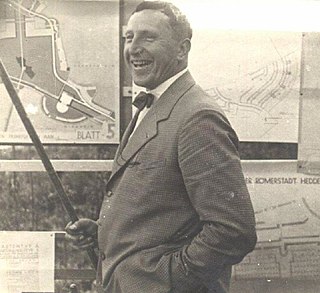
Ernst May was a German architect and city planner.

The Hauptwache is a central point of Frankfurt am Main and is one of the most famous plazas in the city. The original name Schillerplatz was superseded in the early 1900s. It lies to the west of Konstablerwache with both squares linked by the Zeil, the central shopping area of the city.

Bockenheim is a quarter of Frankfurt, Germany. It was incorporated into Frankfurt on 1 April 1895 and is part of the Ortsbezirk Innenstadt II.
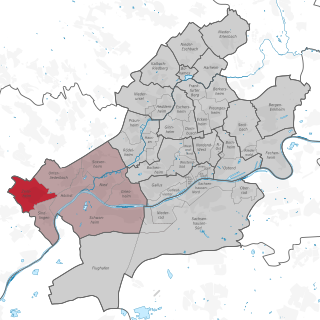
Zeilsheim is a quarter of Frankfurt am Main, Germany. It is part of the Ortsbezirk West and is subdivided into the Stadtbezirke Zeilsheim-Ost, Zeilsheim-Süd and Zeilsheim-Nord.

The Oper Frankfurt is a German opera company based in Frankfurt.

Frankfurt (Main) Hauptbahnhof, also called Frankfurt Central Station and Frankfurt Main Station, is the busiest railway station in the German state of Hesse. Because of its location near the middle of Germany and usage as a transport hub for long and short distance travelling, Deutsche Bahn refers to it as the most important station in Germany.

The PSD Bank Arena is a multi-use stadium in Bornheim, a district of Frankfurt am Main, Germany, and is best accessed by the Johanna-Tesch-Platz U-Bahn station, or the Eissporthalle/Festplatz station. It is currently used mostly for football matches and is the home stadium of FSV Frankfurt and occasionally used to host 1. FFC Frankfurt. With its capacity of 12.542 it is the second largest venue in the city of Frankfurt am Main.

Mörschied is an Ortsgemeinde – a municipality belonging to a Verbandsgemeinde, a kind of collective municipality – in the Birkenfeld district in Rhineland-Palatinate, Germany. It belongs to the Verbandsgemeinde Herrstein-Rhaunen, whose seat is in Herrstein.

The Großmarkthalle, in Ostend, Frankfurt am Main, was the city's main wholesale market, especially for fruit and vegetables. It closed on 4 June 2004 and the building now forms part of the Seat of the European Central Bank. It is considered a major example of expressionist architecture.

The Holy Cross Church is a Catholic church in the Bornheim district of Frankfurt am Main (Germany). It is similar in design to the Frauenfriedenskirche in Frankfurt-Bockenheim. It was built by Martin Weber from 1928 to 1929, on a rise then known as Bornheimer Hang. The church is an unusual example of interwar modernism as sacred Bauhaus architecture.

Philipp Holzmann AG was a German construction company based in Frankfurt am Main.
Martin Weber was a German architect who designed Catholic churches.

Japan Center is a high-rise building in the Innenstadt district of Frankfurt, Germany. The 115-meter-high office tower with 27 floors was completed in 1996.

New Frankfurt was an affordable public housing program in Frankfurt started in 1925 and completed in 1930. It was also the name of the accompanying magazine that was published from 1926 to 1931 dedicated to international trends in architecture, art, housing and education.
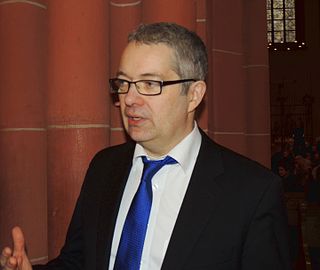
Peter Reulein is a German composer, organ improviser, academic teacher and church musician, from 2000 at the church Liebfrauen in Frankfurt am Main. In 2016 he composed for the Catholic Diocese of Limburg the Franciscan oratorio Laudato si'.

Maria Rosenkranz is a Catholic church in Frankfurt-Seckbach, part of Frankfurt am Main. It was completed in 1953. On 1 January 2015 the parish became a Kirchort, part of the parish St. Josef Frankfurt am Main. The parish church of the Seckbach congregation is part of the Roman Catholic Diocese of Limburg.
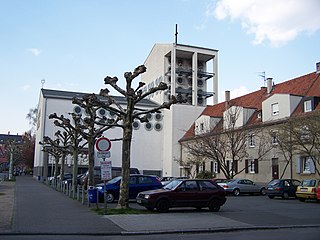
Heilig Geist is the name of a Catholic church in the suburb Riederwald of Frankfurt am Main, Hesse, Germany. The parish church of the Riederwald congregation is part of the Roman Catholic Diocese of Limburg. On 1 January 2015 the parish became a Kirchort, part of the parish St. Josef, Frankfurt.
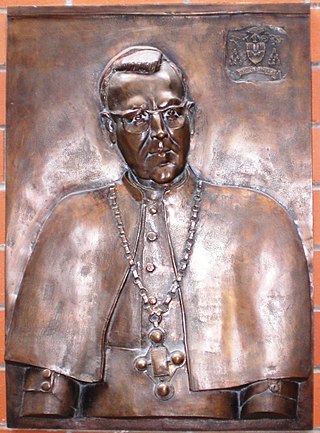
Wilhelm Kempf was a German Catholic theologian who served between 1949 and 1981 as Bishop of Limburg. After the Second World War, he introduced the reforms of the Second Vatican Council to his Diocese.

Post-war reconstruction of Frankfurt was the broad period from 1945 into the 1960s during which the city of Frankfurt am Main in Germany removed the rubble created by Allied raids and the subsequent battle by Allied ground forces to take the city and rebuilt the damaged parts of city.






















